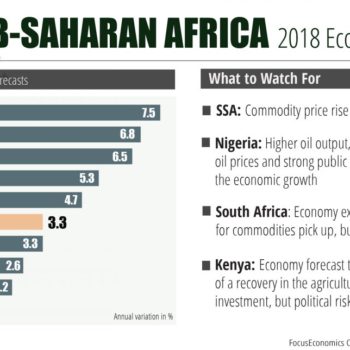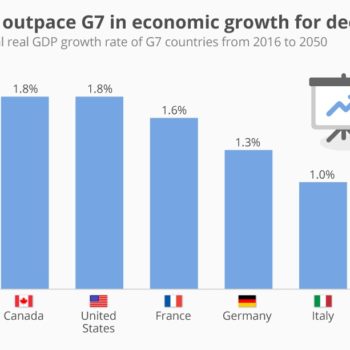
US Economic Outlook and Prediction: For 2018
Experts Prediction and Forecast Steady Growth
We are predicting a healthy U.S. economic outlook according to the key economic indicators and employment. The most critical indicator is the gross domestic product, which measures the nation’s production output and employment statue with the GDP growth rate is expected to remain between the 2 percent to 3 percent ideal range. Unemployment is forecast to continue at the natural rate. There isn’t too much inflation or deflation.
We predict an increase economic growth to 4 percent based on President Trumps promise. That’s faster than is healthy. Growth at that pace leads to an overconfident irrational exuberance. That creates a boom that least to a damaging bust.
Overview and Prediction for 2018 and Beyond
The GDP growth in United States is set to rise to 2.5 percent in 2018. It’s the same as in 2017, but better than the 2.1 percent growth in 2016. The GDP growth rate will be 2.1 percent in 2019 and 2.0 percent in 2020. That’s according to the most recent forecast released at the Federal Open Market Committee meeting on December 13, 2017. This estimate takes into account Trump’s policies.
Also, as predicted, the unemployment rate will drop to 3.9 percent in 2018 and 2019 but rise to 4.0 percent in 2020. That’s better than the 4.1 percent rate in 2017, and the 4.7 percent rate in 2016. It’s also better than the Fed’s 6.7 percent target. But Federal Reserve Chair Janet Yellen admits a lot of workers are part-time and would prefer full-time work.
Majority of the job growth is in low-paying retail and food service industries. Some people have been out of work for so long that they’ll never be able to return to the high-paying jobs they used to have. As a result, the structural unemployment has increased. These traits are unique to this recovery. They also make the unemployment rate seem low.
The Inflation is set to become will be 1.9 percent in 2018, 2.0 percent in 2019 and beyond. It was 1.7 percent in 2017. They are lower than the 2.1 percent rate in 2016, and the 0.7 percent inflation experienced in 2015. The low rates in those years were caused by declining oil prices. The core inflation rate strips out those volatile gas and food prices. The Fed prefers to use that rate when setting monetary policy. The core inflation rate will be 1.9 percent in 2018, 2.0 percent in 2019 and 2020. (It’s unusual that the core rate is that similar to the regular inflation rate.) Fortunately, the core rate is close to the Fed’s 2.0 percent target inflation rate. That gives the Fed room to raise rates to a more normal level.
One of the biggest empolyers U.S. manufacturing is forecast to increase faster than the general economy. Production will grow 2.8 percent in 2018. Growth will slow to 2.6 percent in 2019 and 2 percent in 2020. Those forecasts have not yet taken into account President Trump’s promises to create more jobs.
Interest Rates
The Federal Open Market Committee raised the current fed funds rate to 1.5 percent in December 2017.
It expects to increase this interest rate to 2.1 percent in 2018, 2.7 percent in 2019, and 2.9 percent in 2020.
The fed funds rate controls short-term interest rates. These include banks’ prime rate, the Libor, most adjustable-rate and interest-only loans, and credit card rates. You can protect yourself from the Fed’s rate hikes by choosing fixed-rate loans wherever possible.
The Fed began reducing its $4 trillion in Treasurys in October. It initially said it would do so only after the fed funds rate has normalized to 2.0 percent. But the FOMC decided it would be better to normalize its balance sheet now. The Fed acquired these securities during quantitative easing, which ended in 2014. Since the Fed is no longer replacing the securities it owns, it will create more supply in the Treasurys market.
Oil and Gas Prices
The U.S. Energy Information Administration provides an outlook from 2018-2050. It predicts crude oil prices will average $57/barrel in 2018. That’s for Brent global. West Texas Crude will average around $4/barrel less. The EIA warned that there is still some volatility in the price. It reported that commodities traders believe prices could range between $48/b and $68/b for March 2018 delivery.
A strong dollar depresses oil prices. That’s because oil contracts are priced in dollars. Oil companies are laying off workers, and some may default on their debt. High yield bond funds haven’t done well as a result.
The EIA’s energy outlook through 2050 predicts rising oil prices. By 2025, the average Brent oil price will increase to $86/b (in 2016 dollars, which removes the effect of inflation). After that, world demand will drive oil prices to the equivalent of $117/b in 2050. By then, the cheap sources of oil will have been exhausted, making crude oil production more expensive.
Jobs
The Bureau of Labor Statistics publishes an occupational outlook each decade. It goes into great detail about each industry and occupation. Overall, the BLS expects total employment to increase by 20.5 million jobs from 2010-2020. While 88 percent of all occupations will experience growth, the fastest growth will occur in healthcare, personal care and social assistance, and construction. Furthermore, jobs requiring a master’s degree will grow the fastest while those that only need a high school diploma will grow the slowest.
How It Affects You
We predicted 2018 will be a prosperous year as Americans continue to say goodbye to the effects of the financial crisis. Be on the lookout for irrational exuberance in the stock market. That usually signals the peak of the business cycle. That means another recession is probably two to three years out. It all depends on whether President Trump’s tax cuts will create the jobs he promised.
Furthermore, the best thing is to stay relentlessly focused on your financial well-being. Continue to improve your skills and chart a clear course for your career. If you’ve invested in the stock market, be calm during any pull-back. Plummeting commodity prices, including gold, oil, and coffee, will return to the mean. All in all, an excellent time to reduce debt, build up your savings, and increase your wealth for investors in the American market.
- Posted by admin
- On December 28, 2017
- 0 Comments




0 Comments